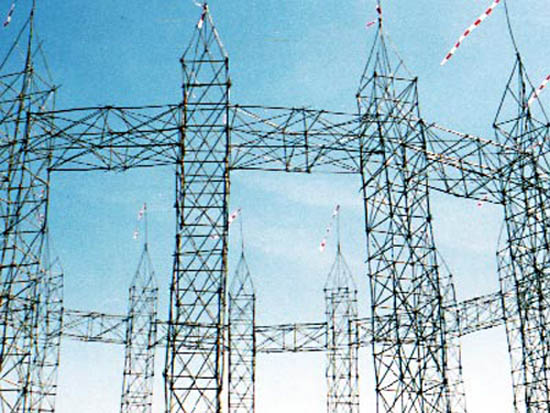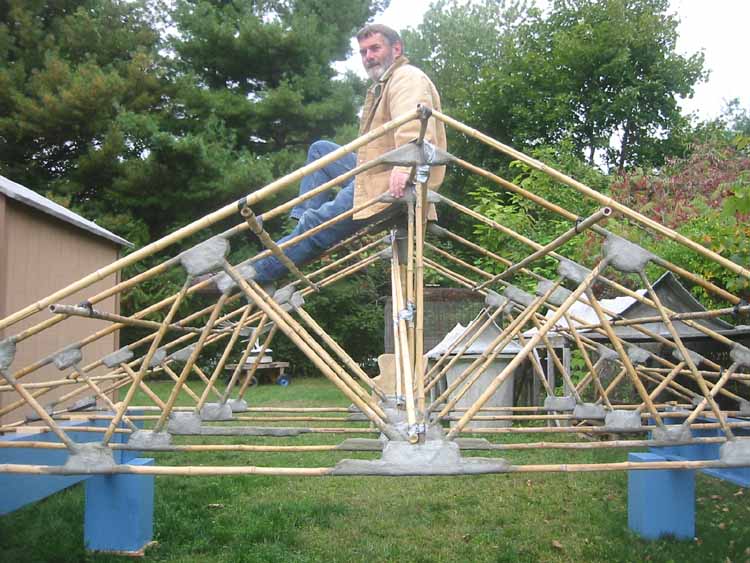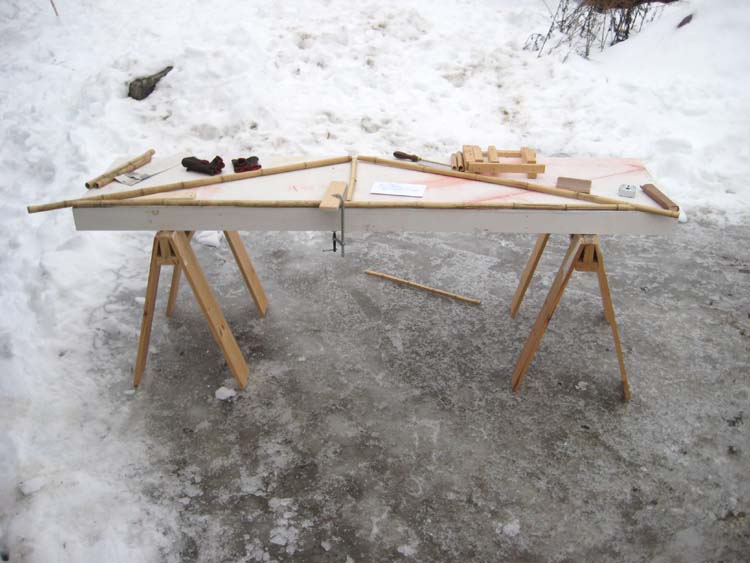
We are ready to collaborate with you. Let us know how to start...
The communique from the above bamboo artists, at emissioni.zero.net, presented this additional keen insight;
Roofs are the subject of concentration at this point only because the supporting walls are relatively simple.
There are several details to keep in mind proceeding into the next subject; frame joints which are wrapped and do not use a fiber packing as was illustrated in the previous truss examples, or a bolt as seen in the lower right of the UNHCR photo, just above the snow load photo. Truss joints as describe next cost about 5Ę each, approximately 1/10 to 1/15 the cost of the bolt in the truss joint pictured above. It is important to note that the bolt shown above works okay for the angled connection but cannot accomplish the Tee joint which is featured later in this chapter.
Antoon Versteegde, the extraordinary bamboo maestro who I am honored to be in consortium with at self-sheltering.org sent me the link to the presentation of collapsed tents under snow load, in Pakistan. He also sent me this photo from other bamboo masters which summarizes the assistance that many stand ready and willing to provide those with thwarted opportunities for self-sheltering. Ferrocement.com and others have proven the economics and durability of this space-age mud and wattle technique using biological fibers, cement, and acrylic. Bamboo masters around the world have proven it can be scaled for schools, hospitals and other large public spaces, even major bridge constructions. Combine the biofiber membrane, 5Ę joint a good supply of bamboo or sapling wood, add plentiful enthusiastic labor, and very soon there will be a functioning hospital or school.

We are ready to collaborate with you. Let us know how to start...
The communique from the above bamboo artists, at emissioni.zero.net, presented this additional keen insight;
"Self-sheltering is indeed a crucial topic for us. And we think that self-sheltering should become a goal, but not only as an emergency response. Emergencies will always occur, this is sure, but the durability and the safety of all human settlements and living environments should be assured by disseminating world-wide the know-how for stable, safe, healthy and ecological housing. It is a matter of knowledge, standards, laws, information and help to people who can build their own house PREVENTING eventual disasters. You obviously know what I mean. And I am sure you agree."
The mock truss roof assembly shown below is lightly taped together and the bamboo is old, thin-wall, low-grade and split; if it will hold me like this, it will devinitely hold a snow load when the bamboo is encased as the small wood rafters were done in previous chapters. Purlins are the connecting pieces running at right angles to the trusses. They are below the rafter chord of the truss so water flow is not impeded. The purlins are not in the exact roof plane because the dimensional sags provide dimensional strength greater than a flat plane.

The next joint examples use Ceramicrete, the binder material developed at the Argonne National Laboratory, mentioned previously. The following photographs illustrate its interesting possibilities; at this point, the ceramic base phosphate binder is proven completely worthy for bamboo or sapling joint attachments used in truss or wall frame field construction or component prefabrication.
Two clarifying points are needed before proceeding. First, roofs are the focus of discussion because supporting walls are comparatively easy, a point brought up because some people have suggested association with wall specialists. Second, wall frame and truss joints could also be made with acrylic and cement mix, plain cement, or cloth treated with carpenter’s waterproof glue, a process described in chapter five and long known to stage prop designers. The ceramic concrete is a good binder because it hardens rapidly and the jig which holds the frame material can be used again much sooner. Acrylic mix and waterproof carpenter's glue may be handled the next day, handle acrylic mix joints gently for 4 - 5 days, standard concrete joints shouldn't be moved for at least 3 - 4 days and, then, gently, for 7 - 10 days (use careful curing procedure with plain portland cement wraps).
A third point, socioeconomic in nature, is inserted here preliminarily, just to ensure it's not overlooked. Shelter is a need shared by all, it defines a basic right of life as important as clean air, water, warmth and the conscious idea of freedom to enjoy planet earth. This website maintains contact with many people involved with shelter, water works and art.
Okay, most of the bases leading up to the 5Ę joint have been covered. I attempted to salute the awesome efforts of those who still struggle in Pakistan by building this to match their conditions; I failed, at first, sliding on the ice gave me a stiff back. This chapter was put together with hope for those in Pakistan who are still working to overcome a devastating earthquake and chilling winters.
